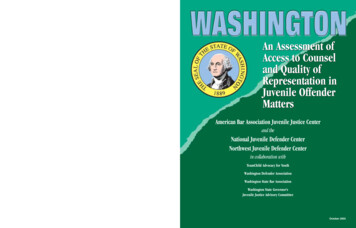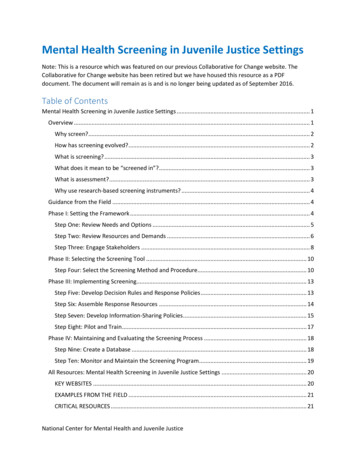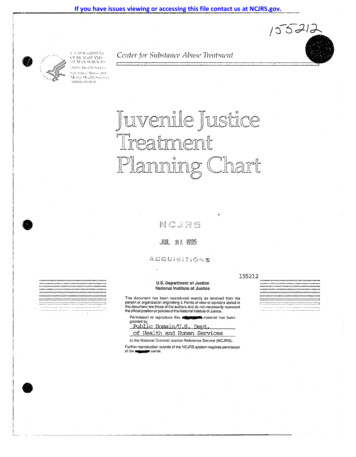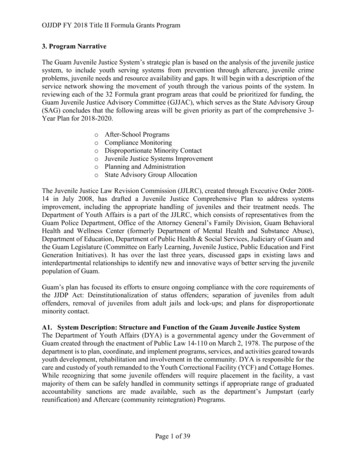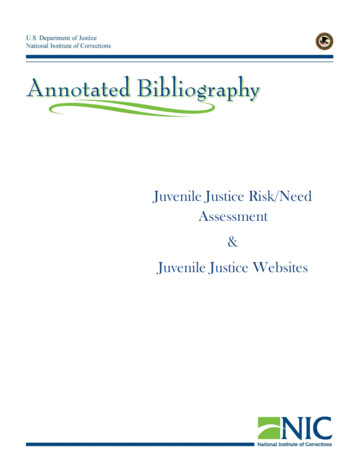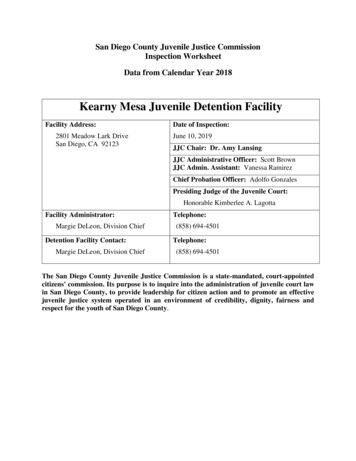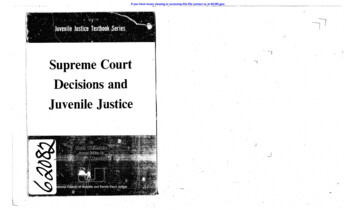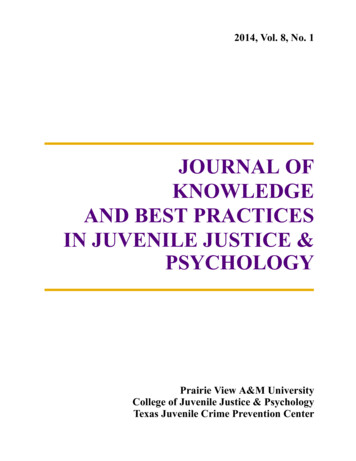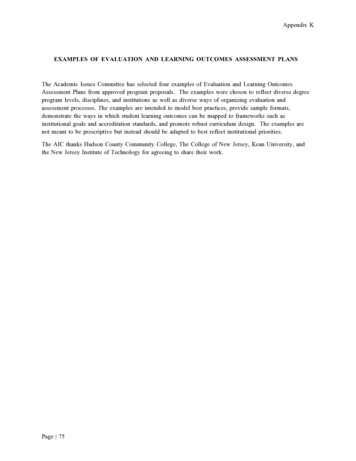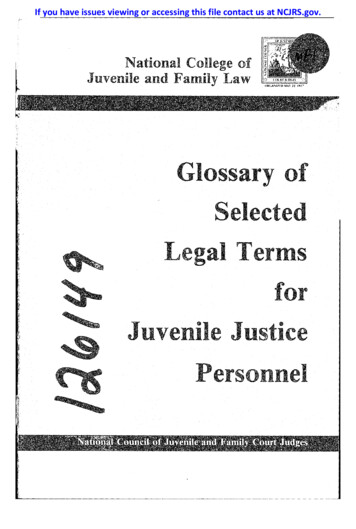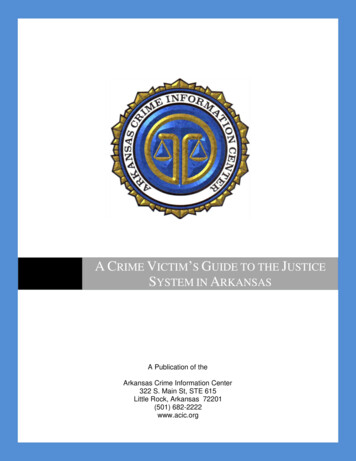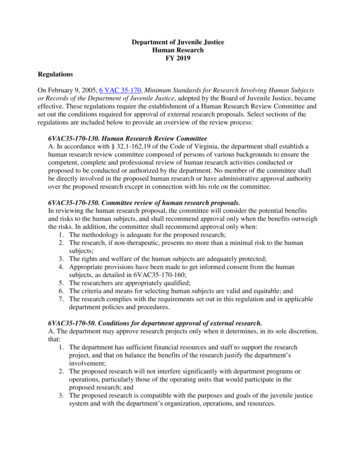
Transcription
Department of Juvenile JusticeHuman ResearchFY 2019RegulationsOn February 9, 2005, 6 VAC 35-170, Minimum Standards for Research Involving Human Subjectsor Records of the Department of Juvenile Justice, adopted by the Board of Juvenile Justice, becameeffective. These regulations require the establishment of a Human Research Review Committee andset out the conditions required for approval of external research proposals. Select sections of theregulations are included below to provide an overview of the review process:6VAC35-170-130. Human Research Review CommitteeA. In accordance with § 32.1-162.19 of the Code of Virginia, the department shall establish ahuman research review committee composed of persons of various backgrounds to ensure thecompetent, complete and professional review of human research activities conducted orproposed to be conducted or authorized by the department. No member of the committee shallbe directly involved in the proposed human research or have administrative approval authorityover the proposed research except in connection with his role on the committee.6VAC35-170-150. Committee review of human research proposals.In reviewing the human research proposal, the committee will consider the potential benefitsand risks to the human subjects, and shall recommend approval only when the benefits outweighthe risks. In addition, the committee shall recommend approval only when:1. The methodology is adequate for the proposed research;2. The research, if non-therapeutic, presents no more than a minimal risk to the humansubjects;3. The rights and welfare of the human subjects are adequately protected;4. Appropriate provisions have been made to get informed consent from the humansubjects, as detailed in 6VAC35-170-160;5. The researchers are appropriately qualified;6. The criteria and means for selecting human subjects are valid and equitable; and7. The research complies with the requirements set out in this regulation and in applicabledepartment policies and procedures.6VAC35-170-50. Conditions for department approval of external research.A. The department may approve research projects only when it determines, in its sole discretion,that:1. The department has sufficient financial resources and staff to support the researchproject, and that on balance the benefits of the research justify the department’sinvolvement;2. The proposed research will not interfere significantly with department programs oroperations, particularly those of the operating units that would participate in theproposed research; and3. The proposed research is compatible with the purposes and goals of the juvenile justicesystem and with the department’s organization, operations, and resources.
Virginia Department of Juvenile JusticeHuman Research, FY 20196 VAC 35-170-190. Committee reports required.A. In accordance with § 66-10.1 of the Code of Virginia, the Human Research ReviewCommittee shall submit to the Governor, the General Assembly, and the director at leastannually a report on human research projects approved by the committee and the status of suchresearch, including any significant deviations from the proposals as approved.B. The committee shall also annually submit to the Board of Juvenile Justice the same report asrequired by subsection A.Human Research Review CommitteeDuring FY 2019, the Department of Juvenile Justice’s (DJJ) Human Research Review Committee(HRRC) was comprised of members from various backgrounds. Jessica Schneider, Ph.D. (Chair) – Research Manager, DJJRobin Binford-Weaver, Ph.D. – Director, Behavioral Services Unit, DJJVince Butaitis – Director, 15th Court Service Unit, DJJWill Egan – Policy Analyst, Virginia Commission on YouthMichael Favale – Legislative & Policy Director, DJJAlan Hullette – Superintendent, Roanoke Valley Juvenile Detention CenterRebecca Smith – Graduate Student, Virginia Commonwealth UniversityLara Todd – Education Administrative Hearings Specialist, DJJDJJ Research Analyst Dhara Amin, Ph.D., serves as the Coordinator of External Research.In addition to reviewing the human subjects research studies as defined in the Regulations, a subcommittee of the HRRC reviews research proposals involving de-identified case-specific data. Thefollowing report includes research projects involving either human subjects or de-identified casespecific data.In accordance with § 32.1-162.19, Human research review committees, an executive summary ofcompleted projects can be found in Appendix A.
Virginia Department of Juvenile JusticeHuman Research, FY 2019I. Research ProposalsIn fiscal year (FY) 2019, DJJ received eight research proposals. Of these, the HRRC and theDirector approved five. At the time of this report, two proposals were pending a review decision,one proposal was closed administratively, and no proposals were denied.* The graph above represents the number of research proposals. Proposals were counted by the most recent submissiondate, including amendments.* The two research proposals pending and one research proposal administratively closed in FY 2019 are not included inthe graph above.II. Active StudiesIn addition to the studies approved in FY 2019, 19 research studies approved in previous yearsremained active. The 24 active studies are summarized below:Evaluation of the Office of Juvenile Justice and Delinquency Prevention (OJJDP) FY 2010Second Chance Act Juvenile Offender Reentry Demonstration ProjectsResearcher: Akiva LibermanInstitution: Urban InstituteApproval Date: July 21, 2014 (first); May 5, 2015 (most recent)The purpose of the study was to evaluate the implementation and outcomes of five OJJDP FY 2010Second Chance Act juvenile demonstration programs, including the Tidewater, Virginia, ReentryInitiative. The researcher conducted implementation and cost analyses through process evaluationsof program materials, evaluations on the use of evidence-based practices, interviews with staff andstakeholders, and focus groups with program participants and their parents. The researcherevaluated the impact of the program by interviewing youth within 45 days of release from a juvenilecorrectional center (JCC) and again within eight months of release. Outcome measures, includingsatisfaction levels, recidivism, and school data, were used to evaluate program impact and
Virginia Department of Juvenile JusticeHuman Research, FY 2019performance. A draft of the final report was submitted to the National Institute of Justice (NIJ) inAugust 2019 and is pending approval. The results indicate that youth who participated in theJuvenile Second Chance Act projects had lower rearrest and reconviction rates.Development and Validation of an Actuarial Risk Assessment Tool for Juvenile Sex OffendersResearcher: KiDeuk KimInstitution: Urban InstituteApproval Date: February 9, 2015The purpose of the study was to develop and validate a risk assessment tool for juvenile sexoffenders and to examine the effects of sex offender intervention services provided in the JCCs. Theresearcher requested demographic, criminal history, treatment services, and Youth AssessmentScreening Instrument (YASI) data from DJJ. Using this data, the researcher aimed to identifyfactors predictive of sexual offending among juvenile offenders and eventually develop a riskassessment. The researcher found that when one risk prediction model performed well in onesetting, it often classified individuals in another setting differently (e.g., high risk individuals wouldbe identified as low risk). The researcher recommended that DJJ avoid utilizing “off-the-shelf”assessment tools without extensive customization, including updating the weights of the variouspredictor variables. A risk assessment tool was not created nor provided by the researcher.Cognitive Behavioral Interventions for Medium- and High-Risk Juvenile Offenders:Practitioner-Researcher Partnership ProjectResearcher: KiDeuk KimInstitution: Urban InstituteApproval Date: April 17, 2015The purpose of the study was to examine the implementation and impact of two treatmentmodalities, Aggression Replacement Therapy (ART) and modified Dialectical Behavior Therapy(DBT), on committed juveniles’ attitudes, behaviors, and recidivism. Juveniles designated as havingan aggression management treatment need were randomly assigned to participate in one of the twotreatment modalities. Staff members who provided treatment participated in interviews regardingtheir experiences and perceptions of the treatment modalities. There were 429 surveys collectedfrom youth who participated. The researcher found that DBT moderately reduced rearrest rates;however, the differences were not statistically significant.Examining Probation Outcomes and Changes in RiskResearchers: JoAnn Lee, Faye Taxman, and Mark MurphyInstitution: George Mason University and DJJApproval Date: March 7, 2016The purpose of the study is to examine the effects of juveniles’ risk-need profiles, changes in riskneed profiles, and services on juveniles’ probation outcomes. Juveniles’ risk-need profiles are theYASI risk and protective scores and legal, family, and substance use domain scores. Theresearchers will examine probation outcomes in the form of recidivism data for one full year. DJJdelivered data to the researchers on July 20, 2017, and an updated data set on June 29, 2018. As ofJune 2019, the researchers have begun to analyze the data.
Virginia Department of Juvenile JusticeHuman Research, FY 2019Neural Correlates of Adolescent Preferences and Perceptions of RiskResearchers: Brooks King-Casas and Nina Lauharatanahirun (student)Institution: Virginia Tech Carilion Research InstituteApproval Date: December 1, 2016The purpose of the study was to examine how adolescents perceive risk and make decisions aboutrisky behavior. The researchers recruited youth involved in any capacity with CSUs 23 and 23A.The researcher wanted to compare this sample to a sample of non-justice-involved youth of thesame ages. Youth completed a series of psychological/behavioral questionnaires while undergoing afunctional magnetic resonance imaging (fMRI) by trained technicians. While receiving the fMRI,youth completed risk perception and risky decision-making tasks. The fMRI detects cerebral bloodflow to different brain regions during these tasks. As of January 2018, five youth have participatedand completed the study. Due to recruitment issues, and because the grant expired, the researchersdecided not to continue this study.FY 2014 Evaluation of the Office of Victims of Crime Vision 21: Linking Systems of Care forChildren and Youth State Demonstration – Service Provider SurveyResearchers: Sara Debus-Sherrill and Mary SpoonerInstitution: ICFApproval Date: January 19, 2017The purpose of the study was to evaluate the implementation of Virginia’s Vision 21: LinkingSystems of Care for Children and Youth project. In order to obtain baseline data regarding thenature of needs and services prior to the implementation of the Vision 21 project, the researcherssurveyed child-serving frontline staff at CSUs 16 and 28. The researchers wanted to administerthese surveys again after the project has been fully implemented. The researchers emailed the onlinesurvey to a contact person at each pilot site. This email asked the contact person to share the surveywith staff who provide direct services to children, youth, and families. The Service Provider Surveyasked questions about the types of services provided by the organization, the demographics of theclients the organization serves, screening tools, interagency collaborations, and areas forimprovement. ICF has received three survey responses from CSU 16 and three responses from CSU28. The researchers closed the survey in March 2017 and do not intend to recruit at other CSUs.Toward a Pedagogy of Possibility: Justice System Involved Youth Read and Write AlternativeTextsResearcher: Judith Dunkerly-BeanInstitution: Old Dominion UniversityApproval Date: March 20, 2017The purpose of the study is to qualitatively examine how justice-involved youth living at theTidewater Youth Services Crisis Center read, respond to, and create alternative texts, while alsoimproving youths’ reading and writing skills and motivations. In the present study, the researcheradministers informal reading inventories to assess juveniles’ reading level and interests and thenassigns selected readings intended to improve reading comprehension, fluency, and vocabulary. Theresearcher also provides reading support and intervention to youth as needed. The researcher andjuveniles then participate in group-based discussions about the reading. Finally, the juvenilesrespond to the text by creating their own alternative text, specifically a ‘zine (magazine), or anotherself-selected representation of self-expression. The researcher focuses on helping juveniles improve
Virginia Department of Juvenile JusticeHuman Research, FY 2019written literacy proficiencies as well as developing their identities as writers. The researcher alsoadministers reading inventories to obtain post-intervention data for those juveniles that remained atthe Crisis Center for a sufficient amount of time to collect post-data. As of March 2018, staff at theTidewater Youth Services Crisis Center reported an increase in the amount of unprompted readingand writing by youth. The program is still active and was transformed into a collaborative venturewith eligible youth.FY 2014 Evaluation of the Office of Victims of Crime Vision 21: Linking Systems of Care forChildren and Youth State Demonstration – Network Provider SurveyResearchers: Sara Debus-Sherrill and Mary SpoonerInstitution: ICFApproval Date: March 27, 2017The purpose of the study was to evaluate the implementation of Virginia’s Vision 21: LinkingSystems of Care for Children and Youth project. In order to obtain baseline data regarding thenature of needs and services prior to the implementation of the Vision 21 project, the researcherssent the Network Provider Survey to a primary point of contact at both CSU 16 and CSU 28. Theprimary point of contact (or designee) was supposed to complete the survey, answer questionsrelated to the agency’s experience with the Vision 21 project (e.g., has your agency had regularmeetings, do the benefits of participating in this project outweigh the drawbacks, does your agencyprovide/receive referrals from Vision 21 project partner agencies). The participating sites struggledwith maintaining engagement with their stakeholders, collecting data, and completing tasks duringthe assigned timeframes. Consequently, the participating sites have not fully implemented theproject. The researchers provided recommendations for how to continue to develop the current sites.The researchers do not intend to recruit at other CSUs.Social and Psychological Predictors of Delinquency in Youth in the DJJ SystemResearchers: Aradhana Bela Sood and Mark MurphyInstitution: Virginia Commonwealth University Health System and DJJApproval Date: May 18, 2017The purpose of the study is to examine the demographic, social, and psychological characteristicsthat relate to juvenile delinquency and recidivism. The researchers are investigating the extent towhich mentoring relationships mitigate and mental health issues exacerbate juvenile delinquency.The researchers are collecting data through case file reviews of committed juveniles and throughdata requests to DJJ. DJJ and the researchers are currently working to finalize and submit the datarequest. The researchers requested another year of recidivism data for their analyses.Vision 21: Linking Systems of Care for Children and YouthResearchers: Laurie CrawfordInstitution: Virginia Commonwealth UniversityApproval Date: May 26, 2017; amended May 6, 2019The purpose of the study is to pilot the Virginia Victimization Screen (VVS), a screening tool usedto assess victimization, associated symptomatology, and protective factors, at CSUs 16 and 28. CSUdirectors selected DJJ staff to become VVS administrators. The VVS is utilized for all juveniles thatare diverted or placed on probation with a moderate or high-risk YASI score. The VVSadministrators also make referrals to appropriate partner agencies as needed. The researchers hope
Virginia Department of Juvenile JusticeHuman Research, FY 2019to validate this screening tool by requesting case specific, de-identified data from other standardscreening tools (i.e., YASI, Substance Abuse Subtle Screening Instrument, Adverse ChildhoodExperiences Questionnaire). In addition, VVS administrators meet with researchers for regularmeetings that include ongoing technical assistance. During these meetings, the researchers inviteDJJ staff to participate in pre- and post-surveys. The staff survey focuses on perceptions of crosssystem collaborations. The first and second waves of the pilot program are complete. The researchersubmitted an amendment to include CSU 18 in the next wave; however, the CSU elected not toparticipate. The researcher also submitted an amendment to expand the study to include CSU 13.A Preliminary Analysis of Juvenile Length of Stay (LOS) and RecidivismResearcher: Patrick LoweryInstitution: Virginia Commonwealth UniversityApproval Date: June 12, 2017The purpose of the study was to evaluate what characteristics influence juveniles’ placements onprobation, commitment to DJJ with an indeterminate sentence, or commitment to DJJ with adeterminate/blended sentence, as well as their LOS. The study examined the relationship betweenLOS and placement type on recidivism. The study also examined differences in the outcomevariables as they relate to changes in the LOS Guidelines, which went into effect on October 15,2015. The researcher requested existing de-identified, case-specific data for demographicinformation, most serious offense(s), placement decision, commitment type, LOS, YASI risk andprotective scores, a subset of specific YASI items, and recidivism data. The researcher constructed aregression model to create a predicted LOS based on characteristics of the case and the juvenile, aswell as a model to predict recidivism based on placement type, commitment type, and LOS. Theresearcher did not find racial disparities in LOS. The researcher found that high-risk malesexperienced the longest LOS compared to low- and moderate-risk males. The researcherrecommended collecting data on plea agreements to better understand juveniles’ LOSs.Validation of Virginia’s Juvenile Risk Assessment InstrumentResearchers: Hayley Cleary and Jessica Schneider (student)Institution: Virginia Commonwealth UniversityApproval Date: July 6, 2017The purpose of the study was to validate Virginia’s juvenile risk assessment instrument, YASI. Theresearchers requested de-identified, case-specific data for juveniles placed on probation or parolebetween FY 2014 and FY 2016 in order to assess the predictive validity, equity by sex and race, andusability of the instrument in case planning. The researchers examined the accuracy of the tool forVirginia's population and staff's utilization of the tool in selecting service priority areas. JessicaSchneider was recused from DJJ's processing, review, and approval of this study due to her roles ofDJJ Research Manager and external student researcher. The research study was completed inNovember 2018. The study found that the predictive validity of the overall and dynamic risk scoresand levels was statistically equivalent for males and females. The Community/Peers and Familydomains had stronger predictive validity for males than females. In addition, YASI in Virginiaperformed as expected in comparison to existing research on youth risk assessment instruments.
Virginia Department of Juvenile JusticeHuman Research, FY 2019Juvenile Justice – Translational Research on Interventions for Adolescents in the Legal System(JJ-TRIALS) National SurveyResearcher: Dr. Christy ScottInstitution: Chestnut Health SystemsApproval Date: November 1, 2017The purpose of the study was to examine the needs and the availability of services for youth oncommunity supervision. The researchers surveyed nine CSUs to gain insight into the current state ofsubstance use, HIV and mental health screenings, assessment, prevention, and treatment for youthunder community supervision. The survey consisted of several different parts that were completedby individuals with various roles within the system. For example, the survey had fact-basedquestions about available services, which could be completed by individuals in various roles. Therewere also opinion-based questions, which the CSU directors had to complete. The data collectionwas completed in January 2019. The nine CSUs had a response rate of 78%. The researcher foundthat only 28% of respondents collaborated with HIV/STI prevention providers. Of those whoreported not collaborating with an HIV/STI prevention provider, the most common reasons includedHIV/STI was not an issue (43%) or because a community provider did not exist (20%). Theresearcher identified a need for implementing improved data systems for youth information, theirneeds, and services across various disciplines.Multi-State Validation of Youth Risk and Needs AssessmentsResearchers: Zachary HamiltonInstitution: Washington State UniversityApproval Date: November 7, 2017The purpose of the study is to first validate Virginia’s juvenile risk assessment instrument, YASI,and then compare the tool’s validity across multiple states that use the same or similar instruments.The researcher will weigh YASI fields and/or scores differentially based on locality in order toimprove the tool’s predictability. To do so, the researcher is requesting de-identified, case-specificdata for all YASI items for juveniles placed on probation or released from direct care between FY2013 and FY 2016, as well as demographic information, treatment information, and recidivism ratesat multiple follow-up periods. The researcher is converting all variables in the data to be compatiblewith the scoring conventions of the multi-state project.Chesterfield/Colonial Heights Juvenile Drug Court EvaluationResearchers: Tara KunkelInstitution: National Center for State CourtsApproval Date: November 28, 2017The purpose of the study was to evaluate the effectiveness of drug court. To do so, the researchercompared the outcomes of juveniles who completed drug court in Chesterfield or Colonial Heightsagainst juvenile offenders who were released from probation supervision between FY 2008 and FY2011. The researcher requested demographic information, YASI items related to drug and alcoholuse, and YASI items related to legal history in order to match juveniles on probation with juvenilesfrom drug court. The researcher found that the drug court program performed well, as the overallrecidivism rates were lower than the comparison group. Specifically, 41% of JDC participants wereconvicted of a new offense within 24 months of exiting the program. Approximately 36% ofparticipants were convicted of at least one misdemeanor.
Virginia Department of Juvenile JusticeHuman Research, FY 2019Evaluation of a Comprehensive Community-Level Approach to Youth ViolenceResearchers: Derek Chapman and Diane BishopInstitution: Virginia Commonwealth UniversityApproval Date: November 28, 2017The purpose of the study is part of a larger project aimed at learning more about youth violence inlow-income neighborhoods of Richmond, Virginia. In the proposed study, the researchers willexamine retrospective, de-identified data for juveniles between the ages of 10 and 24 who wereassociated with an intake case at CSU 13 between 2012 and 2016. The researchers are requestingdata on intake decisions, juvenile demographics, offense information, DAI ranking, select YASIitems, length of stay (if applicable), and recidivism rates. Since the researchers are interested inlow-income neighborhoods of Richmond, such as Mosby Court, Gilpin Court, and Creighton Court,they are requesting individual block-level geographical data. The researchers trained the DJJResearch Unit staff on how to clean and geocode the data manually. The researchers identified thevariables they need from DJJ and have submitted an amendment, which is currently pending.Understanding Youth Engagement in the Plea ProcessResearcher: Allison RedlichInstitution: George Mason UniversityApproval Date: February 1, 2018The purpose of the study was to learn more about juveniles’ engagement in the plea process byinterviewing juvenile and adult offenders who accept a plea bargain. Prince William County CSUassisted the researcher by notifying her when plea hearings occurred for eligible juveniles (i.e., overage 14 and charged with a felony) so that the researcher could attend and recruit participantsimmediately after the hearing. In February 2019, the researcher notified the agency that the projectwill not continue due to recruitment issues.Virginia Personal Responsibility Education Program Innovative Strategies (VPREIS)Researcher: Amanda DainisInstitution: James Madison UniversityApproval Date: February 20, 2018; amended: September 18, 2018; March 29, 2019The purpose of the study is to evaluate the Vision to You program, an evidence-based teenpregnancy program. The program’s main outcomes include the following: (i) to reduce thefrequency of sexual activity; (ii) to reduce the number of sexual partners; and (iii) to increasecontraceptive use among participants. Another goal of this project is to increase knowledge relatedto healthy sexual practices. The program is collaborating with seven juvenile detention centersthroughout the state. Eligible youth are asked if they would like to participate, and the research staffcollects parental consent information. Once the youth complete the online program, they have theopportunity to participate in three post-program surveys. Notably, youth can simply participate inthe program or participate in the program and the surveys. The researcher submitted twoamendments in order to incorporate questions recommended by the grant monitor. There have been70 participants across seven juvenile detention centers. The researcher is continuing enrollment atthe detention centers.
Virginia Department of Juvenile JusticeHuman Research, FY 2019Youth Photography Focus GroupResearcher: Allison ChappellInstitution: Old Dominion UniversityApproval Date: May 10, 2018The purpose of the study was to evaluate a new photography class offered to court-involved youthin collaboration with the Norfolk CSU, Norfolk Public Library, and Old Dominion University. Theresearcher conducted a focus group for the participants enrolled in the photography course toevaluate the impact of a prosocial activity with engaged adults. In order to participate in thephotography course, the youth must complete an application and a panel interview with the CSUand ODU staff. Using the Positive Youth Development model, the focus group questions gatheredinformation regarding the participants’ general attitude and outlook and their perceptions of theclass, the library, their peers in the course, and the teacher. These questions assisted the researchteam in developing future pre- and post-course surveys that will be distributed in later offerings ofthe photograph course. This project also served as Mark Wood’s (CSU #4 Parole Supervisor) JTICapstone project. The researcher found the youth have a mainly positive perception of thephotography course. Participants shared that they felt respected and some expressed feeling a familybond develop within the program.Third National Survey of Youth in Custody (NSYC-3)Researcher: David CantorInstitution: WestatApproval Date: June 14, 2018; amended: July 23, 2018The purpose of the study is to collect data for the National Survey of Youth in Custody, as requiredto meet the mandates of the Prison Rape Elimination Act (PREA). The two primary objectives ofthe survey are to: (i) identify facilities with the highest and lowest rates of victimization, and (ii)provide data for the development of national standards for preventing sexual victimization incorrectional facilities. This will be the third of four surveys. The researchers’ sample frame includeseither state-owned or operated facilities that hold at least 10 adjudicated youth (and the adjudicatedyouth comprise more than 25% of the total youth population in the facility) or contract facilities thathouse at least 10 adjudicated youth (including at least one state-placed adjudicated youth). DJJand/or the selected detention centers will participate in the parental consent process in some form;however, in order to accommodate the selected facilities, the process and Westat’s involvement mayvary. Youth with parental consent who have been in the selected facility longer than four weeks willbe invited to participate in the survey. The HRRC committee has voiced concern with the study’salternative questions as they are sensitive in nature and may make some youth uncomfortable.However, the committee also recognizes the inconvenience of requesting that Westat change theirentire survey instrument for one state. Out of the 276 youth who were enrolled among the sixfacilities in Virginia, 164 youth participated in the survey. The Research Unit is currently indiscussions with Westat about a possible protocol violation. Their progress reported that Spanishforms were utilized; however, Spanish forms were not submitted to HRRC to review nor approvedfor use in Virginia. The organization has stated that the Spanish would have been available uponrequest; however, the issue is that Spanish forms were never a part of the approved protocol.
Virginia Department of Juvenile JusticeHuman Research, FY 2019Connection, Safety, Fairness, and Purpose: A Follow-Up StudyResearchers: Ryan ShanahanInstitution: Vera InstituteApproval Date: July 26, 2018The purpose of the study was to provide a follow-up to the surveys the researcher administered tocommitted juveniles in 2015.
Toward a Pedagogy of Possibility: Justice System Involved Youth Read and Write Alternative Texts Researcher: Judith Dunkerly-Bean Institution: Old Dominion University Approval Date: March 20, 2017 The purpose of the study is to qualitatively examine how justice-involved youth living at the
